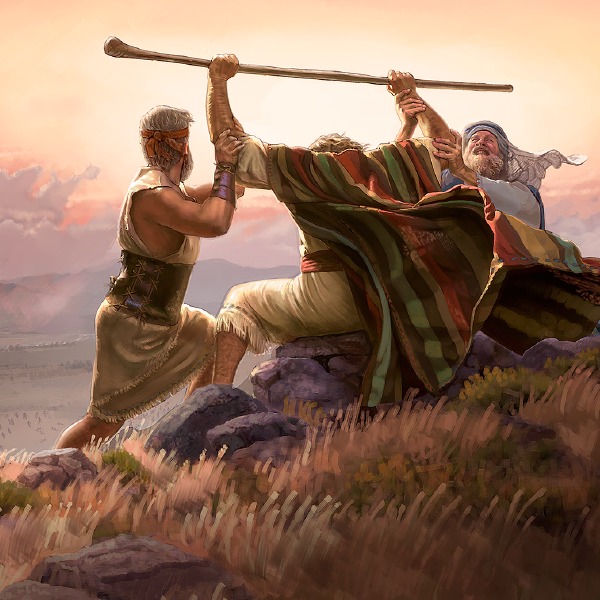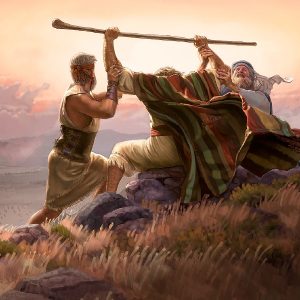 A big mazel tov to Rebbetzin Nancy, and Rabi Kenneth Hain who will be celebrating their 50th wedding anniversary this coming shabbis at Congregation Both Sholom, here in Lawrence, N.Y. A big kiddush to follow a much-anticipated great lookback and speech. The Oisvorfer and eishes chayil can fill many paragraphs -maybe even pages- with warm personal feelings towards the Hains, ober, for the sake of brevity, will just say this: together, they have taken Beth Sholom and the greater Five Towns to new heights. They have also become good friends with many. May the coming decades and anniversaries be filled with good health, and nachas from children, grandchildren and great-grandchildren. Omen!
A big mazel tov to Rebbetzin Nancy, and Rabi Kenneth Hain who will be celebrating their 50th wedding anniversary this coming shabbis at Congregation Both Sholom, here in Lawrence, N.Y. A big kiddush to follow a much-anticipated great lookback and speech. The Oisvorfer and eishes chayil can fill many paragraphs -maybe even pages- with warm personal feelings towards the Hains, ober, for the sake of brevity, will just say this: together, they have taken Beth Sholom and the greater Five Towns to new heights. They have also become good friends with many. May the coming decades and anniversaries be filled with good health, and nachas from children, grandchildren and great-grandchildren. Omen!
And a big mazel tov shout out to Lisa and Howard Rubin who celebrated the birth last week and the beautiful and meaningful bris earlier this week of their first grandchild born to their children Alexandra and Zevi Litwin. Mazel tov to both extended families and especially to the great grandparents who had the merit to attend this special event. May Shmuel Moshe Litwin give his parents and all around him much and only nachas and joy.
Raboyseyee and Ladies
Paying It Forward
For over 3000 years Yiddin have been complaining. Why? Because it’s our mesora. What’s a mesora? It’s the transmission of Jewish traditions passed on over the generations. In plain English: it’s our ancestral right to complain; our ancestors did much of it, especially so in this week’s parsha, It’s our tradition. Shoin, let’s learn some parsha.
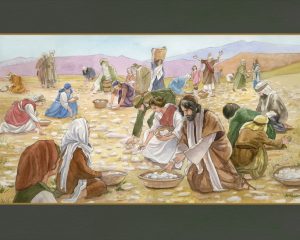 Last week: after 210, or 400 or 430 years, the Yiddin left Mitzrayim. This week: Paroy will give chase – he wants his slaves back- the RBSO will split the sea, the hapless and downtrodden Yiddin will complain to Moishe not once and not twice but five different times. Let’s chazir: they complain about leaving Mitzrayim and slavery, crossing the Red Sea, a lack of water, a lack of food, and the fact that they had to eat mun (manna) for 40 years; a happy and content bunch they were not. The bottom line: in a classic case of ‘what have you done for me lately,’ when faced with adversity, they were of little faith. Let’s ober give them a pass; they were still a broken people and who could blame them? The good news: by next week’s parsha, they will all be healed –physically and spiritually, fully recovered from their state of malaise, and ready to marry and accept the RBSO’s heylige Toirah which they got as a wedding gift. Ober weeks before the wedding which was to take place at Revelation on Har Sinai and just as our parsha comes to a close, we read of a war, one waged by a not so fine gentleman by the name of Amolake. The Yiddin were attacked. We have previously discussed him and why the RBSO despised him and his people so; this year we will instead meet a good guy in the same story.
Last week: after 210, or 400 or 430 years, the Yiddin left Mitzrayim. This week: Paroy will give chase – he wants his slaves back- the RBSO will split the sea, the hapless and downtrodden Yiddin will complain to Moishe not once and not twice but five different times. Let’s chazir: they complain about leaving Mitzrayim and slavery, crossing the Red Sea, a lack of water, a lack of food, and the fact that they had to eat mun (manna) for 40 years; a happy and content bunch they were not. The bottom line: in a classic case of ‘what have you done for me lately,’ when faced with adversity, they were of little faith. Let’s ober give them a pass; they were still a broken people and who could blame them? The good news: by next week’s parsha, they will all be healed –physically and spiritually, fully recovered from their state of malaise, and ready to marry and accept the RBSO’s heylige Toirah which they got as a wedding gift. Ober weeks before the wedding which was to take place at Revelation on Har Sinai and just as our parsha comes to a close, we read of a war, one waged by a not so fine gentleman by the name of Amolake. The Yiddin were attacked. We have previously discussed him and why the RBSO despised him and his people so; this year we will instead meet a good guy in the same story.
Who is this guy and what role does he play? Let’s meet Chur, a fine gentleman from a good family who appears this week and again one more time during the eygel caper, before he disappears from the text for good. Ober, in order to chap and properly get to know him, we must read five pisukim from the parsha. Says the heylige Toirah (Shmois 17:8-12), azoy:
(8) Then came Amolake, and fought with Israel in Rephidim. (9) And Moishe said unto Yihoishua: ‘Choose us out men, and go out, fight with Amolake; tomorrow I will stand on the top of the hill with the rod of G-d in my hand.’ (10) So Yihoishua did as Moishe had said to him, and fought with Amolake; and Moishe, Aaron, and Chur went up to the top of the hill. (11) And it came to pass, when Moishe held up his hand, that Israel prevailed; and when he let down his hand, Amolake prevailed. (12) But Moishe’s hands were heavy; and they took a stone, and put it under him, and he sat thereon; and Aharoin and Chur stayed up his hands, the one on the one side, and the other on the other side; and his hands were steady until the going down of the sun.
Let’s chazir: Amolake, perennial enemy of the Yiddin comes to make war. Moishe tells Yihoishua to select an army of men to go out and fight the enemy. Moishe then adds this, “tomorrow, I will go out and stand on top of the hill….” The Yiddin respond to the threat. Moishe, Aharoin and Chur go up to the hilltop, Moishe with staff in hand. Moishe is standing on the heights as the battle’s rage in the valley below. Whenever he raises his hands, the Yiddin win, but when he lowers them, they begin to lose. After a while, Moishe’s arms get tired. Aharoin and Chur sit Moishe down on a rock, stand on either side of him and support his arms. And through their actions, by nightfall Yihoishua is able to rout the enemy. Gishmak.
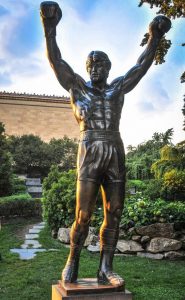 And before we go further, mistama you’re wondering azoy: Why were Moishe’s hands tired and heavy? How does the lifting of his hands help determine a war? Were his hands weaponized a la Bruce Lee? Why was Moishe sitting on a rock and who is this guy named Chur? Says the Michilta, azoy: the RBSO made Moishe’s hands tired as a punishment. Why was Moishe punished? For appointing Yihoishua and not entering into the thick of the battle himself. Alternatively, because he told Yihoishua to select the troops instead of him handling that matter himself, and or, because he delayed going to battle Amolake until “tomorrow.” What’s pshat? Moishe should have immediately responded when Amolake attacked. For tarrying and telling Yihoishua to get ready and that he, Moishe would go up to the top of the hill only ‘tomorrow,’ he shirked his leadership responsibilities and was punished with tired hands. Why was he punished with tired hands? You decide which of the above answers talks to you.
And before we go further, mistama you’re wondering azoy: Why were Moishe’s hands tired and heavy? How does the lifting of his hands help determine a war? Were his hands weaponized a la Bruce Lee? Why was Moishe sitting on a rock and who is this guy named Chur? Says the Michilta, azoy: the RBSO made Moishe’s hands tired as a punishment. Why was Moishe punished? For appointing Yihoishua and not entering into the thick of the battle himself. Alternatively, because he told Yihoishua to select the troops instead of him handling that matter himself, and or, because he delayed going to battle Amolake until “tomorrow.” What’s pshat? Moishe should have immediately responded when Amolake attacked. For tarrying and telling Yihoishua to get ready and that he, Moishe would go up to the top of the hill only ‘tomorrow,’ he shirked his leadership responsibilities and was punished with tired hands. Why was he punished with tired hands? You decide which of the above answers talks to you.
For another more spiritual view, let us also read what the heylige Mishneh and medrish (also of course heylig) had to say. Says the medrish (Tanchuma 27:2): Moishe’s hands grew tired as do those of a man holding three jars of water suspended from his very hands. And asks the medrish azoy: “did they not have a mattress or a pillow upon which he could sit? This informs us azoy: that day, the people were engaged in the community fast.” Stop rolling your eyes in disbelief and let’s instead roll with the medrish which continues azoy: “at times of fasting, pillows and mattresses are not utilized. Accordingly, Aharoin and Chur propped up his hands, one on one side, one on the other side and because of this they (our rabbis) decreed that no less than three people should stand before the ark to read the prayers at a public fast.” Taka a very nice medrish, ober does it answer any of our questions? Ver veyst. Let’s dig deeper.
Asks the Mishneh (Rosh Hashono 29a:6) azoy: did the hands of Moishe make war when he raised them, or break war when he lowered them? What’s taka pshat? Rather the verse comes to tell us that as long as the Yiddin turned their eyes upwards and subjected their hearts to their Father in Heaven, the RBSO, they prevailed, but when not, they fell. And that’s taka what the words in the heylige Toirah tell us explicitly. The war was, during the battle, being won and lost based on how the Yiddin were acting, based on their belief that only the RBSO could save them.
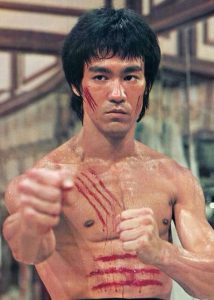 The bottom line according to the Mishneh is this. Moishe’s hands did not perform a miracle; they merely pointed upward. They directed the eyes and thus the minds of the Yiddin toward the RBSO up in heaven. That gave them courage, inner strength, hope, and faith to prevail. In other words, the hands of Moishe acted as a spiritual directive: trust in the RBSO and He will deliver you from the hands of your enemy. Spurn that trust, and you will suffer defeat. Gishmak! And taka says Dovid Hamelech (Tihilim 121:1) “I lift my eyes toward the heavens, from where does my help come? My help comes from the RBSO, maker of heaven and earth. Better than Bruce Lee!
The bottom line according to the Mishneh is this. Moishe’s hands did not perform a miracle; they merely pointed upward. They directed the eyes and thus the minds of the Yiddin toward the RBSO up in heaven. That gave them courage, inner strength, hope, and faith to prevail. In other words, the hands of Moishe acted as a spiritual directive: trust in the RBSO and He will deliver you from the hands of your enemy. Spurn that trust, and you will suffer defeat. Gishmak! And taka says Dovid Hamelech (Tihilim 121:1) “I lift my eyes toward the heavens, from where does my help come? My help comes from the RBSO, maker of heaven and earth. Better than Bruce Lee!
The bottom line of these pisukim: though we have not properly been introduced to Chur, suddenly he’s epes an important player, a macher in the war, efsher a co-general –along with Aharoin- as the Yiddin are forced to fight against the Amalokites. He’s right at Moishe’s side as war is waged and won. And while Moishe’s hands are up in the air, Chur is hands-on, mamish! The bottom line: Chur was one of the three people who went up the hill to pray for salvation. He was obviously a man of stature who was close to his venerated uncles Moishe and Aharoin? Chur was their nephew? We shall explore that below. As an aside our rabbis teach us that every generation has its own version of Amolake fighting wars of some sort against the Yiddin. Oy vey.
Having played this pivotal role, Chur shows up again in parshas Ki Sisa –one final time while alive- where we read these words from the heylige Toirah in Shmois 24: 12-14:
(12) And the LORD said unto Moishe: ‘Come up to Me into the mount and be there; and I will give thee the tables of stone, and the law and the commandment, which I have written, that thou mayest teach them.’ (13) And Moishe rose up, and Yihoishua his minister; and Moishe went up into the mount of G-od. (14) And unto the elders he said: ‘Tarry ye here for us, until we come back unto you; and, behold, Aharoin and Chur are with you; whosoever hath a cause, let him come near unto them.’
Let’s chazir: Moishe is summoned up to the mountaintop to receive the Aseres Hadibrois (Ten Commandments). He’s accompanied by Aharoin to a point. He then tells the elders to wait midway, and that whomever has an issue –while he’s gone- should consult with Aharoin and Chur, seemingly, either or both. So far we know this about Chur: he’s been shouted out in two parshas. He seemingly played a critical role in helping Moishe wage war against Amolake and his people, and if you read the words above carefully, Chur is to co-manage the Yiddin while Moishe is away. And then? He’s seemingly gone without a trace never to be seen or heard from again. Is that emes? We shall soon find out.
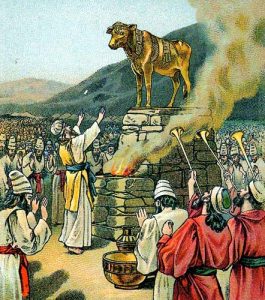 Efsher you’re wondering why the heylige Toirah goes radio silent on Chur’s whereabouts? One day he’s a war general, the next, he’s co-managing the Yiddin and then gone? What’s pshat? Efsher you’re taka wondering what became of him? And so was the medrish who then solved the lacuna of his disappearance with this incredible myseh: Rebbe Birachya said in the name of Rebbe Abba Bar Kahna azoy: at some time –with Moishe still up on the mountain- the Yiddin came to believe that Moishe had died (why they thought him dead and not late will be explained below). In any event, they wanted a replacement leader. They approached Chur and told him to build them an eygel. Because Chur knew better, he refused their request. And because he did not listen to their demands, they killed him. Over and out, no more Chur! Next they went to Aharoin and you know the rest of the story; Aharoin saw that the enraged mob killed Chur –according to many sources, and as mentioned above, Chur was his nephew- and worried for his own life while trying to stall for time, Aharoin concocted a plan which in the end, somehow produced an eygel out of the melted gold. OMG! How that happened, ver veyst.
Efsher you’re wondering why the heylige Toirah goes radio silent on Chur’s whereabouts? One day he’s a war general, the next, he’s co-managing the Yiddin and then gone? What’s pshat? Efsher you’re taka wondering what became of him? And so was the medrish who then solved the lacuna of his disappearance with this incredible myseh: Rebbe Birachya said in the name of Rebbe Abba Bar Kahna azoy: at some time –with Moishe still up on the mountain- the Yiddin came to believe that Moishe had died (why they thought him dead and not late will be explained below). In any event, they wanted a replacement leader. They approached Chur and told him to build them an eygel. Because Chur knew better, he refused their request. And because he did not listen to their demands, they killed him. Over and out, no more Chur! Next they went to Aharoin and you know the rest of the story; Aharoin saw that the enraged mob killed Chur –according to many sources, and as mentioned above, Chur was his nephew- and worried for his own life while trying to stall for time, Aharoin concocted a plan which in the end, somehow produced an eygel out of the melted gold. OMG! How that happened, ver veyst.
And they thought Moishe was dead, why? Grada this topic belongs later in parshas Ki Sisa ober since we’re discussing Chur’s murder and the eygel, let’s review this medirsh which tells us azoy. Says the medrish (Shmois Rabbah 41:7), azoy: after the Jewish nation miscalculated the day Moishe was to return, the Soton (Satan) showed them an image of a dead Moishe being carried in the firmaments of heaven. The Yiddin were shocked. Instead of following Moishe’s very clear instructions for them to visit with Ahroin and or Chur should any issues arise in his absence, Chur was instead approached with a solution. They demanded that he make them a new god who would subsequently lead them. Shoin, when he refused, they killed him.
An angry mob of Yiddin killed him? OMG! Ober was murder not yet outlawed? It was indeed. When? This ugly myseh nebech took place but 40 days after Revelation where they heard these words: “Thou shall have no other god.” What did the hapless Yiddin do? They had an eygel built, they danced and celebrated before it. And just twoscore after saying yes to “Don’t commit adultery,” they broke that cardinal rule as well. Medrish tells us (as does the movie version with Charlton Heston and Yul Brynner depict) that Yiddin -or perhaps they weren’t, ver veyst- were engaged in partying which included sexual depravity, say it’s not so please. In other words: these people, whomever they were, committed idolatry, adultery, and also murder, the Big Three! Oy vey! And for this the RBSO chose them to be His? Seemingly though they themselves may have been stiff, if you chap, too much stiff competition they did not have, as medrish tells us that the other umois ho’oilom (other nations of goyim) were even worse. What could be worse than committing idolatry, sexual depravity and murder? Are these not the big three? Nu, let’s give them a break; they were after all slaves for the past 210 years and as slaves, mistama were used to lewdness and other not so holy rituals including idolatry. Let’s recall the angels arguing with the RBSO that the Yiddin too were idolaters and not worthy of being saved. Are these the same Yiddin who but 40 days earlier yelled out -in unison- naseh v’nishma (we shall do and we shall listen)? Grada, if memory serves correct, we haven’t read a case of Jewacide (made up word) since Kayin killed Hevel; so happens they weren’t even Jewish! Was this murder sanctioned? Where was the RBSO to protect Chur? Was this his payback for assisting Moishe twice? Were the people punished? Speaking of murder, in a few weeks, we’ll be reading how Moishe instructs the Yiddin to kill the eygel participants and how they taka wiped out 3000 people. Nu, according to some, those participants were mostly, or all, part of the Erev Rav, those who tagged along when the Yiddin left Mitzrayim; efsher we can kler they weren’t really Jewish, ver veyst? Ober Chur? Murder? What’s taka pshat?
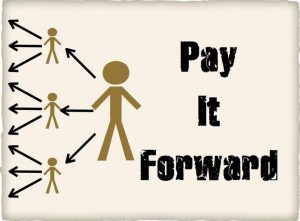 And who was this mystery man? Where did he come from? Who were his parents? His wife? Did they have kids together? Who were they? Moreover, asks the medrish (Vayikra Rabba 10:3) azoy: why was Chur’s murder not mentioned in the pesukim? Why is the heylige Toirah silent? Nu, avada you know when the heylige Toirah goes silent, our sages of yore spoke up. And who proffered answers? The medrish avada which tells us this gishmake myseh of how the RBSO does in fact not forget those who serve Him. Not necessarily right there and them; seemingly at times, He instead pays it forward.
And who was this mystery man? Where did he come from? Who were his parents? His wife? Did they have kids together? Who were they? Moreover, asks the medrish (Vayikra Rabba 10:3) azoy: why was Chur’s murder not mentioned in the pesukim? Why is the heylige Toirah silent? Nu, avada you know when the heylige Toirah goes silent, our sages of yore spoke up. And who proffered answers? The medrish avada which tells us this gishmake myseh of how the RBSO does in fact not forget those who serve Him. Not necessarily right there and them; seemingly at times, He instead pays it forward.
In a few weeks we will be meeting of a wunderkind by the name of Betzalel who at the age of 13 is appointed chief architect and GC of the Mishkan project. At the time of his introduction, the heylige Toirah will shout his lineage and tell us that he was the son of Uri and the grandson of Chur. That’s Chur’s shout-out. The medrish (Shmois Rabbah) will be wondering azoy: why was Chur mentioned when delineating Betzalel’s lineage. More typically we meet Toirah personalities by their name only. On special occasions, the heylige Toirah will tell us who their father was. Case in point: when we meet Yihoishua, he’s introduced as Hoishaya bin nun. As well when we meet the Miraglim (spies), each is shouted out with his and his father’s name. When we meet Kolave (also one of the spies but a good one), the Toirah introduces him as Kolave ben Yifuneh. Ober Betzalel is introduced as being the son of Uri and the grandson of Chur. And as you can imagine, that did not go unnoticed by our sages who had a knack for these nuances. Of course the medrish also wants to know how a 13 year old bar mitzvah boy snared the coveted job of lead architect and general contractor. And why would the heylige Toirah mention that Chur is Betzalel’s grandfather?
Ober raboyseyee as we read above, Chur died a martyr refusing to get involved with the eygel –a sin that angered the RBSO for generations; some say even until today. Chur stood up against the angry crowd and paid with his life. At that moment, the RBSO promised to reward Chur for his act ‘mesiras nefesh’ (self-sacrifice). The payback for Chur’s heroism was that he had a grandson with the talents of Betzalel who was entrusted with the task of constructing the Mishkan. For this reason, Chur’s name is mentioned when Betzalel is introduced. The RBSO did not forget; it just took a while. Avada the RBSO had a payback plan, it involved Chur’s grandson, Betzalel. The bottom line: all agree that Chur was a good man, ober who was his father? Earlier we asked azoy: where did the Chur come from? He suddenly appears without an introduction. Ober not to worry as answers to Chur’s lineage can be found in Divrey Hayomim
(I Chronicles 2:18-20) where we read azoy:
(18) And Kolave the son of Chetzroin begot children of Azuva his wife and of Yireois, and these were her sons: Yesher, and Shoivov, and Ardon. (19) And Azuva died, and Kolave took unto him Ephros, who bore him Chur. (20) And Chur begot Uri, and Uri begot Betzalel.
Ok, let’s chazir that. We met a gentleman by the name of Kolave the son of Chetzroin who seemingly remarried and had a son by the name of Chur. Later in the heylige Toirah we will meet another gentleman by the name of Kolave who is the son of Yifuneh. Interesting: were there two of them? Moreover, one of these Kolave fellows was married to no lesser a woman than Miriam, the sister of Moishe and Aharoin. And if that’s the case, who the hec was Kolave who marries (see Chronicles) a woman by the name of Ephros? And who fathered Chur? Was Chur the son of Kolave ben Chetzoin and some woman named Ephros? Or, was he the son of Kolave the son of Yifuneh who married Miriam? Was there more than one Kolave and which one of them fathered Chur? Moreover, how can Miriam be married to Kolave ben Chitzron, according to Divrei HaYomim, and Kolave ben Yefuneh according to Gemoro Soita? What story is the midrash trying to tell by making Kolave ben Yefuneh the midrashic father of Chur and Miriam his midrashic mother?
Not that you care, ober the medrish seemingly did and they grada worked very hard to reconcile the Kolave, Miriam and Chur lineage; let’s see how creative they were. Says the heylige Gemora (Soita 11b), azoy: And Azuva died, and Kolave took unto him Ephros (Ephrat), which bore him Chur, and it is written, “Now Dovid was the son of that Ephrathite etc. And Kolave the son of Chetzroin begat children of Azuva his wife and of Yirois, and these were her sons: Yesher and Shoivov and Ardon. Ask the Gemora: “The son of Chetzoin? But wasn’t he the son of Yifuneh!?” No problem whatsoever: Yifuneh and Chetzoin are the same person. He was called Yifuneh because he had a son who turned [panah] from the counsel of the spies. So far so good.
What about Chur’s mother? Who were Azuva and Yeriois who are mentioned in Chronicles? Also not an issue; both were Miriam! And why is she called Azuva? Says the medrish (Shmois Rabbah 1:17): Because everyone abandoned her at first. Shoin, and fartig. She was called Azuva (deserted) since the men didn’t want to marry her when she had the skin disease, tzo’ra’as (after speaking loshoin horo on Moishe). She was called Yeriois since her complexion was similar to undyed curtains. Ober why does the posik tell us that Azuva died? And if Azuva was taka Miriam, she was very much alive and not dead at all!? Also not a problem for the Gemora where even if dead, one can be alive, and which tells us so gishmak azoy: when she was sick with leprosy, it was almost like she died. And why is she called Efros? The name Efros has the root “paru”, “were fruitful.” When Miriam was masquerading around as a midwife (Puah) while defying Paroy’s order to kill all newborn baby boys, she ensured that the Yiddin were fruitful and multiplied. And why does it say that Kolave married Efros? If Efros was Miriam, why not tell us that Kolave married Miriam? Because when she was healed it was like she was a new person and they renewed their wedding vows. Moreover, Dovid Hamelech (King David) was called an Efrosi since he was a descendant of Miriam. Got all that? Veyter!
The bottom line: one cannot outsmart the heylige Gemora or medrish; they were a clever and creative bunch. Chur was seemingly the son of important parents, Miriam and Kolave who may have had several name changes along the way. Efsher the names were changed as the heylige Gemora imagines the stories, or for other reasons, ver veyst? His parents were leaders of Yiddin at critical times. Kolave, as mentioned, was loved by the RBSO (see archives at www.oisvorfer.com. for more on Kolave in prior postings). Chur’s uncles were Moishe and Aharoin and his grandson was Betzalel, the artist chosen to create the artifacts for the mishkan.
A gittin Shabbis-
The Heylige Oisvorfer Ruv
Yitz Grossman
